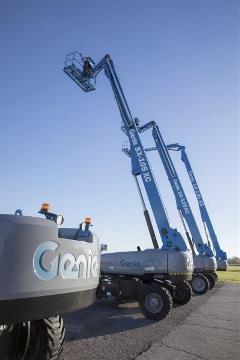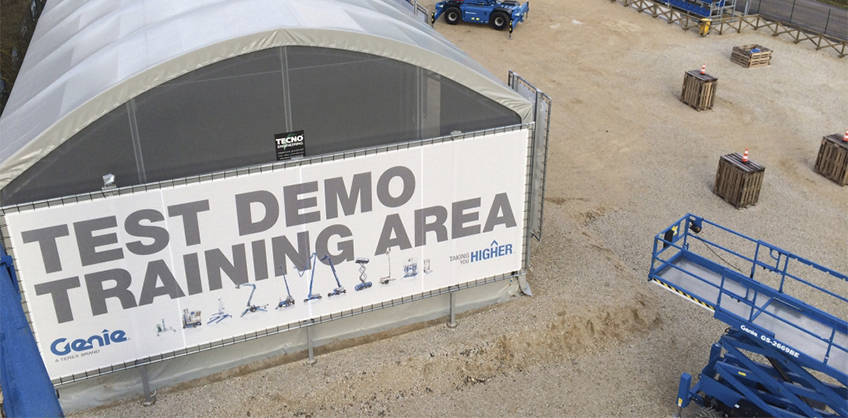Aerial Equipment Safety and Training During the COVID-19 Pandemic
by Scott Owyen - Director of Training On Jul 23, 2020, 03:00 AM
Subscribe To Aerial Pros
Filter by tags
With the outbreak of the novel coronavirus that causes COVID-19, many in the aerial access industry, which includes several types of equipment including mobile elevating work platforms (MEWPs) and telehandlers, are raising questions about the safest way to train operators, provide practical evaluations and disinfect their equipment between use or rentals.
The best way to prevent illness is to avoid being exposed to the virus referenced in the article Recommendations to Prevent the Spread of COVID-19 on Aerial Jobsites.
In addition to keeping jobsite personnel safe during the COVID-19 pandemic, below are key points and suggestions regarding classroom and practical hands-on training and cleaning machines that aerial fleet managers may find useful.
Classroom Training – Tips for Trainers
- The first rule of thumb is to stay at home if you are sick or exhibiting symptoms. Don’t risk exposing others. There will always be another class down the road.
- Clean and disinfect tables and other surfaces that your students may come into contact with. A list of disinfecting products is provided at the end of this article.
- Thoroughly wash your hands prior to placing pens and other training materials at each seat.
- Limit your class size so that participants can maintain social distancing in the classroom (at least 6 ft / 2 m apart). Requiring face coverings in the classroom would be a good additional measure.
- Ensure that participants can thoroughly wash their hands with soap and water on a regular basis. If not, provide each of them with a small container of hand sanitizer.
- Consider providing single-serving containers of donuts or other snacks, rather than the open box of donuts commonly offered. Single bottles of water are also a good option.
- Provide appropriate sanitizing wipes at the coffee maker or other shared appliances.
Practical Hands-on Training
- Clean and disinfect the MEWP or Telehandler prior to providing the practical hands-on training.
- Ensure that all participants are maintaining social distancing and wearing face coverings during your machine walkaround, pre-operation inspection and function tests.
- Provide operators with hands sanitizer to clean their hands after machine operation and remind them to not touch their faces. Have them thoroughly wash their hands with soap and water prior to returning to the classroom.
- If possible, explain the machine controls and theory of operation in a manner that does not require you or another individual to join the operator in the platform during actual operation.
- Even if you can maintain social distancing while in the platform with the operator (e.g. in an 13 ft, or 4 m, platform), you should still consider wearing a face covering.
- Although not recommended, if you are joining the operator on a MEWP with a smaller platform, the CDC (US Centres for Disease Control and Prevention) recommends wearing cloth face coverings where other social distancing measures are difficult to maintain.
- As far as gloves are concerned, the CDC states that, in most other situations, wearing gloves is not necessary. Instead, practice everyday preventive actions like keeping social distance (at least 6 ft / 2 m) from others, washing your hands with soap and water for 20 seconds or using a hand sanitizer with at least 65% alcohol (Genie baskets are now all equipped as standard with a work tray/tool box), and wearing a cloth face covering when you have to go out in public.
- Do not install homemade separation screens or other devices in the MEWP platform. Such devices may affect wind speed ratings, block egress and prevent an individual from reaching the platform controls in an emergency.
- Wear reusable or disposable gloves for routine cleaning and disinfection.
- Clean surfaces using soap and water, then use disinfectant.
- Cleaning with soap and water reduces number of germs, dirt and impurities on the surface. Disinfecting kills germs on surfaces.
- Practice routine cleaning of frequently touched surfaces.
Disinfecting Machines
- We recommend the use of EPA-registered household disinfectants. EPA (US Environmental Protection Agency) 5
- Follow the instructions on the label to ensure safe and effective use of the product. Read EPA’s infographic on how to use these disinfectant products safely and effectively.
Many products recommend: - Keeping surface wet for a period of time (see product label)
- Precautions such as wearing gloves and making sure you have good ventilation during use of the product
- Diluted household bleach solutions may also be used if appropriate for the surface.
- Check the label to see if your bleach is intended for disinfection, and ensure the product is not past its expiration date.
- Unexpired household bleach will be effective against coronaviruses when properly diluted.
Follow manufacturer’s instructions for application and proper ventilation. Never mix household bleach with ammonia or any other cleanser.
Leave solution on the surface for at least 1 minute.
- Bleach solutions will be effective for disinfection up to 24 hours. Please keep in mind that bleach may negatively affect warning labels and other safety markings.
- Alcohol solutions with at least 70% alcohol may also be used.
We will get through this difficult time, and we will get through it together. It is our sincere hope that this information will assist you in continuing to promote safety in our industry, while protecting yourself, your staff, your customers and their jobsites.


